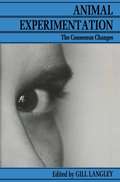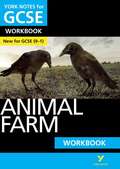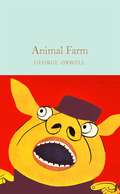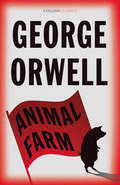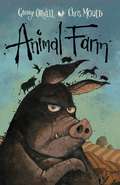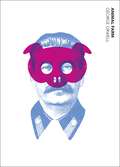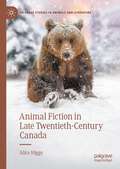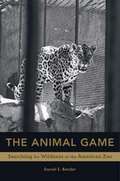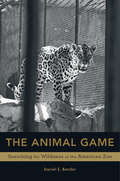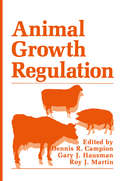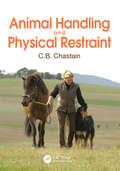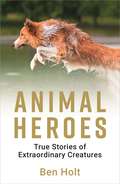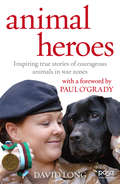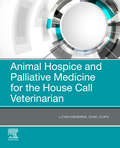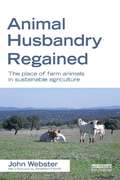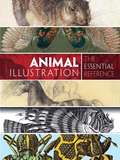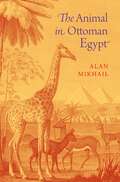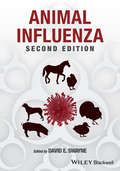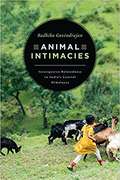- Table View
- List View
Animal Farm: York Notes For Gcse Workbook Grades 9-1
by David GrantLearn: Tasks and answers on every area of the text to enhance your students' learning and take revision further. Practise: Exercises on spelling, punctuation and grammar, and longer exam-style questions with sample response extracts to practise and perfect key skills for writing top quality answers. Test: Support independent learning and motivate students with quick tests and regular self-assessment to stay on track for success.
Animal Farm: Large Print (Macmillan Collector's Library)
by George OrwellPublished in 1945, George Orwell’s famous allegorical story Animal Farm is a satire about the corrupting effects of power which reflect Orwell’s views on the failures of communism.Part of the Macmillan Collector’s Library; a series of stunning, clothbound, pocket-sized classics with gold foiled edges and ribbon markers. These beautiful books make perfect gifts or a treat for any book lover. This edition features an introduction by journalist and writer Jason Cowley.When the old Major, a highly respected white boar, gathers his fellow farm animals to preach about freedom, rebellion and the evils of man, he kicks off a revolution that has been brewing for years. The animals drive out their drunken farmer, Mr Jones, and create their own society which promises equality for all. Two scheming pigs, Napoleon and Snowball, appoint themselves leaders and what begins as a supposedly equalitarian community descends into an increasingly violent and hierarchical society permeated by lies and corruption.
Animal Farm: Large Print (Collins Classics)
by George OrwellThe international bestselling classic from the author of Nineteen Eighty-Four.
Animal Farm: Large Print
by George OrwellAll animals are equal but some animals are more equal than others.It's just an ordinary farm - until the animals revolt. They get rid of the irresponsible farmer. The other animals are sure that life is improving, but as systems are replaced and half-truths are retold, a new hierarchy emerges . . .Orwell's tale of propaganda, power and greed has never felt more pertinent.With an exciting new cover and inside illustrations by superstar Chris Mould.
Animal Farm: Large Print (York Notes Ser.)
by George OrwellTHE AUTHORATITIVE TEXT "All animals are equal, but some animals are more equal than others. "Mr Jones, the owner of Manor Farm, is a lazy drunk. The animals decide to overthrow him in a revolution that will allow them to run the farm, liberating themselves and creating a new life of equality and freedom. But they have underestimated the pigs. Napoleon and Snowball form an elite and take control for themselves, and the tyranny of the farmer is replaced with another kind of control leaving the animals again subject to a ruthless and cruel authority. Imagined only as Orwell could, this powerful fable is instilled with humour and an underlying urgency that makes this one of the most prescient warnings ever written. WITH AN INTRODUCTION BY CHRISTOPHER HITCHENS
Animal Fiction in Late Twentieth-Century Canada (Palgrave Studies in Animals and Literature)
by Alice HiggsAnimal Fiction in Late Twentieth-Century Canada fulfils a vital contribution to the conversation surrounding animal representation as a point of continuity in national narratives and supports the idea that focusing on narratives of responsibility and care influences better relations with both non-human animals and across settler-Indigenous boundaries. Alice Higgs engages with on-going debates regarding reconciliation by demonstrating that it is imperative to critique settler colonial environmental frameworks and place autonomy back into Indigenous communities by bringing Indigenous practices of custodianship and relationality to bear more generally. This book also develops a number of conversations in animal studies in relation to the politics of representation. Higgs studies a range of canonical Canadian authors, demonstrating a progress across the period in which it is possible to identify the emergence of a literary pro-animal turn.
The Animal Game: Searching For Wildness At The American Zoo
by Daniel E. BenderTracing the global trade and trafficking in animals that supplied U.S. zoos, Daniel Bender shows how Americans learned to view faraway places through the lens of exotic creatures on display. He recounts the public’s conflicted relationship with zoos, decried as prisons by activists even as they remain popular centers of education and preservation.
The Animal Game: Searching For Wildness At The American Zoo
by Daniel E. BenderTracing the global trade and trafficking in animals that supplied U.S. zoos, Daniel Bender shows how Americans learned to view faraway places through the lens of exotic creatures on display. He recounts the public’s conflicted relationship with zoos, decried as prisons by activists even as they remain popular centers of education and preservation.
Animal Growth Regulation
by D. R. Campion G. J. Hausman R. J. MartinThe biotechnological advances of recent years have put us on the brink of unprecedented gains in animal productivity. Manipulation of animal growth rate and composition of gain is now possible by a variety of techniques. Ex amples include ingestion of beta-adrenergic agonists, injection of somatotropin, castration, immunization, and gene insertion. Animal Growth Regulation ad dresses modem concepts of growth regulation with an emphasis on agricul turally important animals. This emphasis is not exclusive, as many situations exist in which the only information available was generated in other species, and this information has been included for the sake of clarity and completeness. However, because of the overall orientation of this volume, particular attention has been given to the regulation of skeletal muscle, adipose tissue, and bone growth. Certain hormones and growth factors have a profound influence on growth regulation and this basic physiological knowledge is being harnessed to maniplilate growth. Thus, considerable emphasis has been given to growth hor mone-somatomedinlinsulinlike growth factor regulation of cell and tissue growth. The involvement of peptides coded by protooncogenes and of negative growth regulators, such as transforming growth factor-l3, represents an emerging area of molecular biology wherein basic knowledge offers potential exploitation for growth manipulation. Opportunities also exist for regulation of protein turn over, especially from the standpoint of protein degradation. Therefore, a place was reserved for these topics in order to provide relevant basic knowledge.
Animal Handling and Physical Restraint
by C. B. ChastainKey features: Stresses safety in handling, restraint, and containment of animals Covers handling and restraint of all domestic and common tamed animals and provides information on normal animal behavior and welfare Discusses how to recognize signs in animals of poor handling and containment Reviews zoonotic disease risks to animal handlers, particularly from normal-appearing animals, and how to avoid transmission of disease Features over 200 informative line drawings for clarity and simplicity of illustration Explains how to tie useful knots and hitches and when to use them for restraint Includes basic ethical considerations and legal liabilities of animal handling and containment Presents steps to prevent animal escapes, barn fires, and problems with transport Authored by an experienced veterinary educator in clinical medicine for veterinarians, veterinary students, pre-veterinary students, veterinary technicians and technologists, animal scientists, and animal owners Proper handling and restraint are essential to the welfare of captive animals, allowing them to be examined, groomed and treated in ways that contribute to their optimum quantity and quality of life. The aim of the book is to prepare future or current veterinarians and veterinary technologists, technicians/nurses, and assistants to be able to handle animals more safely and gain the confidence of animals and their owners. In turn, they will be able to instruct owners in proper animal handling methods, reducing the risk of physical injury or mutual infectious diseases. Throughout the book, the author emphasises that each animal is an individual and each handling environment provides its own advantages and disadvantages: handling an animal safely, humanely and efficiently requires practical knowledge of the species’ normal behaviour. This is explored in detail in each of the species-based chapters, which cover proper handling of domestic household and laboratory animals, as well as farm and ranch animals where safe handling aids the producer in both humane practice and greater profitability. After reading this book, the practitioner or student will be versed in the most basic part of the art of veterinary medicine: the safe handling of animals.
Animal Handling and Physical Restraint
by C. B. ChastainKey features: Stresses safety in handling, restraint, and containment of animals Covers handling and restraint of all domestic and common tamed animals and provides information on normal animal behavior and welfare Discusses how to recognize signs in animals of poor handling and containment Reviews zoonotic disease risks to animal handlers, particularly from normal-appearing animals, and how to avoid transmission of disease Features over 200 informative line drawings for clarity and simplicity of illustration Explains how to tie useful knots and hitches and when to use them for restraint Includes basic ethical considerations and legal liabilities of animal handling and containment Presents steps to prevent animal escapes, barn fires, and problems with transport Authored by an experienced veterinary educator in clinical medicine for veterinarians, veterinary students, pre-veterinary students, veterinary technicians and technologists, animal scientists, and animal owners Proper handling and restraint are essential to the welfare of captive animals, allowing them to be examined, groomed and treated in ways that contribute to their optimum quantity and quality of life. The aim of the book is to prepare future or current veterinarians and veterinary technologists, technicians/nurses, and assistants to be able to handle animals more safely and gain the confidence of animals and their owners. In turn, they will be able to instruct owners in proper animal handling methods, reducing the risk of physical injury or mutual infectious diseases. Throughout the book, the author emphasises that each animal is an individual and each handling environment provides its own advantages and disadvantages: handling an animal safely, humanely and efficiently requires practical knowledge of the species’ normal behaviour. This is explored in detail in each of the species-based chapters, which cover proper handling of domestic household and laboratory animals, as well as farm and ranch animals where safe handling aids the producer in both humane practice and greater profitability. After reading this book, the practitioner or student will be versed in the most basic part of the art of veterinary medicine: the safe handling of animals.
Animal Heroes: True Stories of Extraordinary Creatures
by Ben HoltAnimal Heroes contains some of the most extraordinary true tales of bravery across the natural world, from domestic pets to wild animals, proving that when it comes to facing danger there’s more to them than meets the eye.
Animal Heroes: Inspiring true stories of courageous animals
by David LongThe PDSA Dickin Medal (regarded as the animals’ Victoria Cross) has been awarded to just 64 animals, from the Blitz to present day, for their courage in times of crisis. Among these incredible true-life stories you will meet…G.I. Joe the plucky pigeon, who rescued over 100 lives by flying twenty miles in twenty minutes to deliver a message in World War II.Theo the steadfast springer spaniel, who served as a bomb-detection dog in Afghanistan.Rip the trusty mongrel, who saved many victims of the Blitz air-raids.Olga the courageous police horse, who bolted from the path of a flying bomb in World War II only to return to the scene and remain on duty.These heart-warming tales of gallantry and devotion will stay with you long after you turn the pages.Previously published as The Animals' VC.
Animal Hospice and Palliative Medicine for the House Call Vet - E-Book
by Lynn HendrixGain the understanding you need to provide compassionate, end-of-life pet care. Animal Hospice and Palliative Medicine for the House Call Veterinarian provides an all-in-one guide to the skills and challenges related to this growing area of veterinary care. From setting up your business and performing your first in-home consultation to managing pain, performing in-home euthanasia, and providing grief support to the family, this book walks you through each step of care. Written by Dr. Lynn Hendrix, a leading expert and researcher in veterinary palliative medicine, this practical resource shows how to improve the quality of care for pets in the final stages of life. Comprehensive coverage addresses the essential topics of palliative care, hospice, and euthanasia. Key topics range from setting up a mobile business, in-home consultations to pain management, complementary medicine, physical support for the pet, and much more. Information on the diseases commonly seen at the end of life includes disease progression and trajectories. Single-source review covers animal end-of-life care and consulting, specifically through mobile veterinary services. 100 full-color clinical photos depict the concepts and procedures of animal palliative care. Practical insights are provided in the areas of family grief support, compassion fatigue, managing difficult home visits, and dispelling the myths of animal hospice and euthanasia. Author Lynn Hendrix is an expert veterinarian with than a decade of experience in the field of Veterinary Palliative Medicine and is also the owner/founder of Beloved Pet Mobile Vet, a company providing in-home animal hospice and euthanasia.
Animal Husbandry Regained: The Place of Farm Animals in Sustainable Agriculture
by John WebsterThe farming of animals for meat and milk confronts a stark dilemma. While world demand from a growing and more affluent human population is increasing rapidly, there are strong counter-arguments that we should eat less meat and pay more attention to environmental protection, animal welfare and human health and well-being. The aim of this book is to identify and explain the causes and contributors to current problems in animal husbandry, especially those related to 'factory farming', and advance arguments that may contribute to its successful re-orientation. Husbandry is considered in its broadest sense, namely the productive and sustainable use of the land for the good of all (plants, humans and other animals). The first part of the book outlines principles and arguments necessary to engage with current problems: depletion of natural resources and destruction of environment, animal welfare, food and health, fair trade and sharing resources. These arguments are illustrated by examples and sufficient evidence to justify the argument without obscuring the message. The second part presents a series of constructive proposals for change and development in animal husbandry, both in the developed world and subsistence agriculture. These include more integrated crop and livestock farming systems, the ethics of animal welfare and environmental management, and the evolution of a new social contract whereby the rights of the people to a fair share of good, safe food and a green and pleasant land are matched by a shared responsibility to preserve these things.
Animal Husbandry Regained: The Place of Farm Animals in Sustainable Agriculture
by John WebsterThe farming of animals for meat and milk confronts a stark dilemma. While world demand from a growing and more affluent human population is increasing rapidly, there are strong counter-arguments that we should eat less meat and pay more attention to environmental protection, animal welfare and human health and well-being. The aim of this book is to identify and explain the causes and contributors to current problems in animal husbandry, especially those related to 'factory farming', and advance arguments that may contribute to its successful re-orientation. Husbandry is considered in its broadest sense, namely the productive and sustainable use of the land for the good of all (plants, humans and other animals). The first part of the book outlines principles and arguments necessary to engage with current problems: depletion of natural resources and destruction of environment, animal welfare, food and health, fair trade and sharing resources. These arguments are illustrated by examples and sufficient evidence to justify the argument without obscuring the message. The second part presents a series of constructive proposals for change and development in animal husbandry, both in the developed world and subsistence agriculture. These include more integrated crop and livestock farming systems, the ethics of animal welfare and environmental management, and the evolution of a new social contract whereby the rights of the people to a fair share of good, safe food and a green and pleasant land are matched by a shared responsibility to preserve these things.
Animal Illustration: The Essential Reference
by Carol Belanger GraftonComprehensive and entertaining, this volume comprises the greatest works in animal illustration from the Middle Ages through the twentieth century. The chronological presentation of hundreds of black-and-white and color images begins with a medieval illuminated manuscript by the Limbourg brothers and the Renaissance works of Albrecht Dürer and other artists from the first centuries of printing. Subsequent illustrations include the seventeenth-century real and imaginary animals of Matthäus Merian and the unique eighteenth-century compilations of Albertus Seba. Nineteenth-century images are drawn from sources as diverse as J. G. Heck's Bilder Atlas; the prints of Georges Baron Cuvier; William Jardine's 40-volume Naturalist's Library; bird illustrations by John James Audubon, Alexander Wilson, Edward Lear, and many others; extraordinary butterfly and insect images by E. A. Seguy, as well as animal illustrations from Victorian chromolithograph die cuts. The exquisite Edwardian bestiary of the Detmold brothers brings the collection into the twentieth century, and ends with the imagery of contemporary dinosaur artist James Gurney.Detailed bibliographical information concerning every source—including biographical details of each artist—makes this collection a vital reference tool as well as a splendid resource of outstanding animal illustrations. Students of graphic art and illustration, as well as graphic designers and advertising professionals, will prize this treasury of material from many rare historic sources.
The Animal in Ottoman Egypt
by Alan MikhailSince humans first emerged as a distinct species, they have eaten, fought, prayed, and moved with other animals. In this stunningly original and conceptually rich book, historian Alan Mikhail puts the history of human-animal relations at the center of transformations in the Ottoman Empire from the sixteenth to the nineteenth centuries. Mikhail uses the history of the empire's most important province, Egypt, to explain how human interactions with livestock, dogs, and charismatic megafauna changed more in a few centuries than they had for millennia. The human world became one in which animals' social and economic functions were diminished. Without animals, humans had to remake the societies they had built around intimate and cooperative interactions between species. The political and even evolutionary consequences of this separation of people and animals were wrenching and often violent. This book's interspecies histories underscore continuities between the early modern period and the nineteenth century and help to reconcile Ottoman and Arab histories. Further, the book highlights the importance of integrating Ottoman history with issues in animal studies, economic history, early modern history, and environmental history. Carefully crafted and compellingly argued, The Animal in Ottoman Egypt tells the story of the high price humans and animals paid as they entered the modern world.
The Animal in Ottoman Egypt
by Alan MikhailSince humans first emerged as a distinct species, they have eaten, fought, prayed, and moved with other animals. In this stunningly original and conceptually rich book, historian Alan Mikhail puts the history of human-animal relations at the center of transformations in the Ottoman Empire from the sixteenth to the nineteenth centuries. Mikhail uses the history of the empire's most important province, Egypt, to explain how human interactions with livestock, dogs, and charismatic megafauna changed more in a few centuries than they had for millennia. The human world became one in which animals' social and economic functions were diminished. Without animals, humans had to remake the societies they had built around intimate and cooperative interactions between species. The political and even evolutionary consequences of this separation of people and animals were wrenching and often violent. This book's interspecies histories underscore continuities between the early modern period and the nineteenth century and help to reconcile Ottoman and Arab histories. Further, the book highlights the importance of integrating Ottoman history with issues in animal studies, economic history, early modern history, and environmental history. Carefully crafted and compellingly argued, The Animal in Ottoman Egypt tells the story of the high price humans and animals paid as they entered the modern world.
Animal Influenza
by David E. SwayneAnimal Influenza, Second Edition is a comprehensive text on animal influenza. Organized by species, coverage includes avian, swine, equine and mammals, with each section including data on influenza viruses, the infection and disease they cause, and strategies used in control. Covers the full range of topics within avian, swine, equine and mammalian influenzas in one comprehensive and authoritative text Provides a summarization of peer-reviewed and empirical data on influenza viruses, the infection, and diseases they cause Discusses strategies used in control of the disease Leading experts are drawn together to provide an international and multi-disciplinary perspective Fuses latest developments in basic scientific research with practical guidance on management of the disease
Animal Influenza
by David E. SwayneAnimal Influenza, Second Edition is a comprehensive text on animal influenza. Organized by species, coverage includes avian, swine, equine and mammals, with each section including data on influenza viruses, the infection and disease they cause, and strategies used in control. Covers the full range of topics within avian, swine, equine and mammalian influenzas in one comprehensive and authoritative text Provides a summarization of peer-reviewed and empirical data on influenza viruses, the infection, and diseases they cause Discusses strategies used in control of the disease Leading experts are drawn together to provide an international and multi-disciplinary perspective Fuses latest developments in basic scientific research with practical guidance on management of the disease
Animal Intimacies: Interspecies Relatedness in India's Central Himalayas (Animal Lives)
by Radhika GovindrajanWhat does it mean to live and die in relation to other animals? Animal Intimacies posits this central question alongside the intimate—and intense—moments of care, kinship, violence, politics, indifference, and desire that occur between human and non-human animals. Built on extensive ethnographic fieldwork in the mountain villages of India’s Central Himalayas, Radhika Govindrajan’s book explores the number of ways that human and animal interact to cultivate relationships as interconnected, related beings. Whether it is through the study of the affect and ethics of ritual animal sacrifice, analysis of the right-wing political project of cow-protection, or examination of villagers’ talk about bears who abduct women and have sex with them, Govindrajan illustrates that multispecies relatedness relies on both difference and ineffable affinity between animals. Animal Intimacies breaks substantial new ground in animal studies, and Govindrajan’s detailed portrait of the social, political and religious life of the region will be of interest to cultural anthropologists and scholars of South Asia as well.
Animal Intimacies: Interspecies Relatedness in India's Central Himalayas (Animal Lives)
by Radhika GovindrajanWhat does it mean to live and die in relation to other animals? Animal Intimacies posits this central question alongside the intimate—and intense—moments of care, kinship, violence, politics, indifference, and desire that occur between human and non-human animals. Built on extensive ethnographic fieldwork in the mountain villages of India’s Central Himalayas, Radhika Govindrajan’s book explores the number of ways that human and animal interact to cultivate relationships as interconnected, related beings. Whether it is through the study of the affect and ethics of ritual animal sacrifice, analysis of the right-wing political project of cow-protection, or examination of villagers’ talk about bears who abduct women and have sex with them, Govindrajan illustrates that multispecies relatedness relies on both difference and ineffable affinity between animals. Animal Intimacies breaks substantial new ground in animal studies, and Govindrajan’s detailed portrait of the social, political and religious life of the region will be of interest to cultural anthropologists and scholars of South Asia as well.
Animal Intimacies: Interspecies Relatedness in India's Central Himalayas (Animal Lives)
by Radhika GovindrajanWhat does it mean to live and die in relation to other animals? Animal Intimacies posits this central question alongside the intimate—and intense—moments of care, kinship, violence, politics, indifference, and desire that occur between human and non-human animals. Built on extensive ethnographic fieldwork in the mountain villages of India’s Central Himalayas, Radhika Govindrajan’s book explores the number of ways that human and animal interact to cultivate relationships as interconnected, related beings. Whether it is through the study of the affect and ethics of ritual animal sacrifice, analysis of the right-wing political project of cow-protection, or examination of villagers’ talk about bears who abduct women and have sex with them, Govindrajan illustrates that multispecies relatedness relies on both difference and ineffable affinity between animals. Animal Intimacies breaks substantial new ground in animal studies, and Govindrajan’s detailed portrait of the social, political and religious life of the region will be of interest to cultural anthropologists and scholars of South Asia as well.
